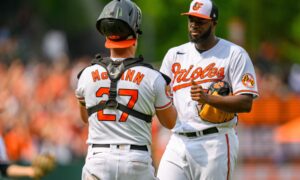SCROLL DOWN TO READ ARTICLE
It’s always tricky business — hammering a club for failing to sign a free agent.
There are plenty of mitigating factors that go into signings, including whether that player wants to be part of a particular organization.
I understand money is always an issue and that teams have varying financial resources and constraints.
All that said, the Orioles fumbled this one. They should have signed outfielder Jon Jay. He’s not a difference-maker, but he’s a perfect fit for what the lineup needed.
Jay is a veteran leader with a World Series ring, a left-handed hitter who can hit righties and lefties equally, a guy who can lead off, who can play all three defensive positions sufficiently and one who has reached base at a .355 career clip, including posting a .374 on-base percentage last year with the Chicago Cubs.
And he ended up being cheap, comparatively speaking. The Kansas City Royals, who are clearly rebuilding, signed Jay to a one-year, $3 million deal with $1.5 million more in incentives on Tuesday, according to The Athletic.
That’s basically the same deal in which the Orioles, who aren’t rebuilding, secured with Colby Rasmus, except Rasmus agreed to a minor-league pact worth $3 million if he made the majors and $2 million in incentives. So, technically, Rasmus could make more in 2018 from the Orioles than Jay can from the Royals.
The issue here is not whether Rasmus is a better player than Jay. He is a year younger (31 to 32) and arguably is a better defender. I’m not saying Rasmus can’t be an upgrade over what the Orioles had in 2017. This isn’t Colby Rasmus bashing. It’s decision-making bashing.
The issue here is that Jay is a much better fit for the 2018 Orioles than Rasmus. Jay may not be the better player, but he was the better fit. Period.
Jay may be the best fit for the Orioles of all of the free-agent offensive players that were out there.
The Orioles players knew that.
Both Manny Machado and Adam Jones made it known to higher-ups that they wanted Jay to be an Oriole, given the entire package he brings to the game and clubhouse. Machado, in particular, considers Jay a close friend, mentor and workout partner in Miami. It would have further improved Machado’s mood, which already has been particularly pleasant in March.
But this isn’t a personal thing. This isn’t about making one player happy.
Jay has been on winning teams, and guys like Machado and Jones want to win now. And feel Jay could have helped them do that.
Plus, the Orioles have coveted a natural leadoff hitter since Nate McLouth left, and Jay has held that role for 30 percent of his career. He’s batted leadoff more than any other spot but second. Rasmus, in contrast, has batted leadoff five times in his 940 career starts. He might be able to do it. So might Tim Beckham. But why jam a square peg into a round hole when round pegs were seemingly available?
Furthermore, Rasmus provides no lineup diversity for the Orioles. He plays good defense – a real plus – and can hit the longball. But he strikes out a ton and doesn’t walk much, or at least not enough to turn a career .242 batting average into a respectable OBP.
Jay is a career .288 hitter with almost no pop, but he can put the ball in play a lot more often than Rasmus. Consider that Rasmus has 600 more plate appearances than Jay in their careers, and 500 more strikeouts.
Rasmus has fanned in 27 percent of his major league plate appearances; Jay in 17 percent. Add in the 44-point difference in career on-base percentage and an either/or decision doesn’t make sense for a club that swings wildly and is continually among the worst teams in baseball every year in getting on base.
On-base percentage was supposed to be a focus of Dan Duquette’s when he took over as executive vice president in 2012. We haven’t seen it. Certainly not consistently.
What we have seen is a lineup without diversification, a group of hairy sluggers that can bludgeon an opponent or corkscrew itself into the ground at any given moment.
Then this weird offseason comes along, when free agent prices get stagnant and Jay, whom Mlbtraderumors.com initially predicted would sign a two-year, $14 million deal with Texas, gets caught in the crashing market.
The Orioles should have been there to provide a soft landing.
Instead, they had no net put up.
I asked Duquette about Jay and Rasmus after the Kansas City signing was announced Tuesday.
This was his response:
“Given the organization’s depth and potential in the outfield, we like the flexibility we have to evaluate our club this spring, and then set our roster,” Duquette said. “We need to see more of Rasmus, and, keep in mind, Austin Hays has all the tools to be an everyday major league player.”
Now, reading between the lines, what I’m getting is that the minor league deal with Rasmus was a difference-maker here. It bought the Orioles time to evaluate what they have in the outfield, not just in Hays, but also Cedric Mullins, Anthony Santander, DJ Stewart and veteran Alex Presley.
Duquette didn’t want to block the path to the majors if a youngster seized the right field job in the spring, and he doesn’t have to earmark a 40-man roster spot for Rasmus yet. Although I see no scenario in which a healthy Rasmus doesn’t make the Opening Day roster.
I might be able to buy the concept of keeping the seat open for Hays or someone else – except Jay ended up with a one-year deal, too. Maybe the Orioles assumed that wouldn’t happen, and instead took the safer buy in Rasmus.
But one of Duquette’s primary strengths as an executive is reading the endgame of the market. And either he didn’t do that properly with Jay or he preferred Rasmus.
And, if it is the latter, then I never want to hear him talk again about diversifying a lineup and searching for on-base percentage guys.
Because there was a golden opportunity for it, and now Jay is on a club-friendly contract in KC.
For years I’ve defended some of Duquette’s moves because I do believe that, in certain instances, he has his hands tied by ownership philosophy, whether it is length of contract for a starting pitcher or lack of involvement in the international amateur pipeline.
I’ve defended his pitching purchases this year because I don’t believe he has the financial go-ahead to add a Jake Arrieta or an Alex Cobb and I think adding Andrew Cashner and Chris Tillman were fine moves given those restraints.
But not being more aggressive in pursuing Jay – for whatever reason – is negligence in my opinion by Duquette, Brady Anderson or whomever else is making the final calls.
Jon Jay may not make this club a World Series team, but he represented something different, something the Orioles’ lineup desperately needed. And, instead, the Orioles ended up with a similar part for basically the same money and same length.
That’s being shortsighted in March, something Duquette and Company usually isn’t.
That’s a mistake that can’t afford to be made given how tenuous this upcoming season’s performance appears.
57 Comments
You must be logged in to post a comment Login or Register Here
Leave a Reply
You must be logged in to post a comment.










